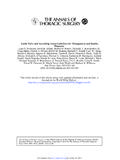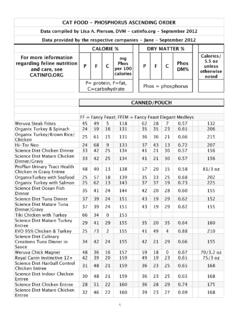Transcription of Helping immigrant students to succeed at school – and …
1 Helping immigrant students to succeed at school and beyond How school systems respond to migration has an enormous impact on the economic and social well-being of all members of the communities they serve, whether they have an immigrant background or not. Some systems need to integrate large numbers of school -age migrants and asylum seekers quickly; some need to accommodate students whose mother tongue is different from the language spoken in the host community or whose families are socio- economically disadvantaged; some systems are confronted with all three challenges at once. The following pages reveal some of the difficulties immigrant students encounter and some of the contributions they offer . while settling into their new communities and new schools. They also summarise some of the policies governments can implement to help immigrant students integrate into their host societies.
2 The material is taken from a forthcoming report drafted by Francesca Borgonovi, Rowena Phair and Mario Piacentini. The fact that the educational, social and emotional success of immigrant students differs so widely across countries, and that countries pursue such different policies and practices in leveraging the potential of immigrant children, underlines that there is much that countries can learn from each other. Andreas Schleicher Director, OECD Directorate for Education and Skills Helping immigrant students TO succeed AT school AND BEYOND OECD 2015 1. immigrant students '. performance in school In most countries, first-generation immigrant students Figure 1: immigrant students ' performance in problem ( students born outside the destination country whose solving, mathematics and reading parents were also born outside that country) perform Performance in computer-based problem solving worse than students without an immigrant background, First-generation I Second-generation I Non- immigrant and second-generation immigrant students (those born in the destination country to parents who were born outside Slovenia of the country) perform somewhere between the two.
3 As Montenegro shown in Figure 1, although many immigrant students Sweden perform relatively poorly compared to non- immigrant Denmark students , they can perform at high levels by international Finland standards. As the figure also shows, the performance of France immigrant students differs widely across countries. Shanghai-China The performance gap between first-generation immigrant Netherlands students and students without an immigrant background Spain tends to be wider in reading than in mathematics or Norway problem solving. This suggests that language barriers to text comprehension may be key in explaining Italy performance differences between these two groups of Austria students . Chile Belgium OECD average Where do immigrant students fare United Arab Emirates better? Israel immigrant students tend to perform better in PISA in Germany countries with highly selective immigration policies.
4 Croatia But while the culture and education students had Serbia acquired before migrating have a profound impact on Portugal students ' achievement at school , the performance of immigrant students is even more strongly related to the Russian Federation characteristics of the school systems in their host country. Czech Republic Ireland United States United Kingdom Hong Kong-China Canada Australia Macao-China Singapore 300 400 500 600 700. Mean score For each chart, countries and economies are ranked in ascending order of the mean score of first-generation immigrant students . Source: OECD, PISA 2012 Database. 2 Helping immigrant students TO succeed AT school AND BEYOND OECD 2015. Figure 1: immigrant students ' performance in problem solving, mathematics and reading (continued). Mathematics performance Reading performance First-generation I Second-generation I Non- immigrant First-generation I Second-generation I Non- immigrant Mexico Mexico Brazil Brazil Argentina Argentina Costa Rica Kazakhstan Greece Iceland Kazakhstan Sweden Sweden Slovenia Jordan Montenegro Chile Finland France Greece Finland Italy Montenegro Jordan Denmark Costa Rica Slovenia France Italy Denmark Spain Austria Iceland Belgium Serbia Norway Norway Germany Qatar Spain Belgium Serbia Portugal Portugal OECD average OECD average Croatia Qatar Austria Chile Germany Croatia Russian Federation Russian Federation United States Switzerland Israel Netherlands Luxembourg Liechtenstein Netherlands Luxembourg Switzerland Czech Republic Czech Republic United States United Arab Emirates Israel United Kingdom United Arab
5 Emirates Liechtenstein United Kingdom Ireland Shanghai-China New Zealand New Zealand Shanghai-China Ireland Australia Macao-China Canada Australia Macao-China Canada Hong Kong-China Hong Kong-China Singapore Singapore 300 400 500 600 700 300 400 500 600. Mean score Mean score For each chart, countries and economies are ranked in ascending order of the mean score of first-generation immigrant students . Source: OECD, PISA 2012 Database. Helping immigrant students TO succeed AT school AND BEYOND OECD 2015 3. Figure 2 shows how, for a selected group of countries with Figure 2: immigrant students ' performance in available information, immigrant students from the same mathematics, by country of origin and destination country of origin and of similar socio-economic status First-generation immigrants' score Second-generation immigrants'.
6 In mathematics adjusted score in mathematics adjusted perform across different destination countries. for socio-economic status for socio-economic status On average, students from Arabic-speaking countries students from Arabic-speaking countries in: who settled in the Netherlands score 100 points higher in mathematics than students from the same countries of Netherlands origin who settled in Qatar, after accounting for socio- United Arab Emirates Denmark economic status. Albanian students in Greece score Finland 50 points higher in mathematics than Albanian students Qatar who settled in Montenegro a difference that is very close to the average performance difference between Greece students from Iraq in: and Montenegro. students born in mainland China score Netherlands above the OECD average in several destination countries/ Finland economies, but they tend to perform better in Hong Kong- Denmark China than in Macao-China.
7 students from China in: Of course, it is not only socio-economic status that Hong Kong-China contributes to differences in performance of immigrant New Zealand students from the same country of origin who settle in Macao-China different destination countries; other factors also play a Australia role, including students ' own motivation or the level of students from Albania in: support they receive from their parents. But these findings suggest that school systems play a large role in integrating Greece immigrant students and that some destination Switzerland Austria countries are better than others at nurturing the talents Montenegro and abilities of students with different intellectual and cultural backgrounds. students from Bosnia and Herzegovina in: Germany Croatia Has performance improved over time? Austria When examining trends in performance differences Montenegro between immigrant students and students without an students from the Russian Federation in: immigrant background, it is important to consider them Finland in the context of changes in the socio-economic profile Latvia of students .
8 Education outcomes have improved in many Israel countries of origin, and migration policies have become Austria increasingly skill-selective. Czech Republic Kyrgyzstan 300 350 400 450 500 550 600. PISA score points in mathematics The average performance by immigrant group and destination country accounts for differences in socio-economic status. It corresponds to the predicted performance of the group if all the immigrant students who migrated from that country of origin and all the non- immigrant students across all the destination countries shared the same socio-economic status of the average student. Only destination countries with data on at least 20 immigrant students are shown. Sources: OECD, PISA 2003, 2006, 2009, 2012 Databases. 4 Helping immigrant students TO succeed AT school AND BEYOND OECD 2015.
9 Figure 3: Change between 2003 and 2012 in immigrant Still, changes in the performance of immigrant students students ' mathematics performance over time also suggest that education policies can Difference in mathematics Difference in mathematics complement social policies in fostering integration. The performance between students performance between students with and without an immigrant with and without an immigrant difference in mathematics performance between students background in 2012 background in 2003 with and without an immigrant background shrank by students WITH an around 10 score points, on average, between 2003 and immigrant background students WITHOUT an immigrant background perform better perform better 2012 (Figure 3). This reduction is still observed even when Hungary -35 comparing students of similar socio-economic status.
10 Australia -29 Among those countries and economies where at least Macao-China 5% of the student population were immigrants in both Slovak Republic -70 2003 and 2012, in Belgium, Germany, New Zealand, Turkey Switzerland and the United States the difference in New Zealand -14 mathematics performance between students with an immigrant background and those without narrowed Ireland during the period. In Belgium, Germany and Switzerland, Canada the narrowing is the result of greater performance Latvia improvements among students with an immigrant Hong Kong-China background than among students without an immigrant United States background. In Germany, the performance disadvantage Thailand among immigrant students shrank: in 2003, non- Russian Federation immigrant students outscored students with an Czech Republic 28 immigrant background by 81 points in mathematics; by OECD average 2003 -10 2012 this difference had decreased to 54 score points.


















